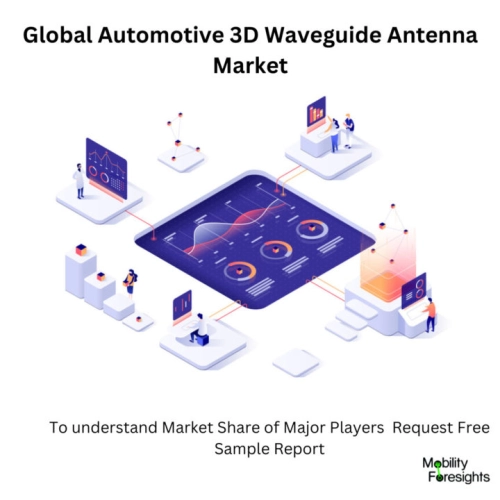
- Get in Touch with Us

Last Updated: Apr 25, 2025 | Study Period: 2023-2030
A cutting-edge form of antenna technology made specifically for use in automobiles is the automotive 3D waveguide antenna.
This sort of antenna uses 3D waveguide technology to send and receive radio signals and is commonly positioned inside the dashboard or roof of the car.
Electromagnetic waves are guided and directed using hollow metal tubes in waveguide technology, a sort of transmission technology.
To increase the performance and dependability of the antenna, a complicated three-dimensional waveguide is built for use in automotive applications.
Utilizing an automotive 3D waveguide antenna has the following advantages:
A more equal distribution of the signal is made possible by the 3D waveguide architecture, which enhances signal quality and reception.
greater Bandwidth: The intricate waveguide structure enables a greater bandwidth, which enables the antenna to receive a wider frequency range.
Better Performance: The 3D waveguide architecture improves overall performance by reducing interference from other electronic components in the car.
The dependability and quality of radio communications in automobiles can be enhanced by the sophisticated and cutting-edge technology known as an automotive 3D waveguide antenna.

The Global Automotive 3D Waveguide Antenna Market accounted for $XX Billion in 2022 and is anticipated to reach $XX Billion by 2030, registering a CAGR of XX% from 2023 to 2030.
In particular, automotive radar for advanced driving systems engineers at HUBER+SUHNER have been working on metalized plastic technology since the early 2000s.
HUBER+SUHNER first introduced the 3D waveguide antenna metalized plastic technology more than ten years ago.
Lightweight 3D waveguide antennas with small form factors have been successfully designed, produced, and validated through a number of innovation processes.
HUBER+SUHNER created the first 3D waveguide metalized plastic antennas, which have been produced there since 2006.3,4.
These products are consistent with international laws and offer high gain and a small form factor for mmWave backhaul at the V- and E-Bands (57 to 66 GHz and 71 to 86 GHz, respectively).
Several designs with 1024 to 4096 radiators each are fed with the same amplitude and phase for this purpose, and they are integrated into a single input.
With this strategy, a radiation pattern is produced that has an extremely focused pencil beam (directivity ranging from 38 to 43 dBi, respectively), controlled sidelobe levels, and steady gain with frequency.
| Sl no | Topic |
| 1 | Market Segmentation |
| 2 | Scope of the report |
| 3 | Abbreviations |
| 4 | Research Methodology |
| 5 | Executive Summary |
| 6 | Introduction |
| 7 | Insights from Industry stakeholders |
| 8 | Cost breakdown of Product by sub-components and average profit margin |
| 9 | Disruptive innovation in the Industry |
| 10 | Technology trends in the Industry |
| 11 | Consumer trends in the industry |
| 12 | Recent Production Milestones |
| 13 | Component Manufacturing in US, EU and China |
| 14 | COVID-19 impact on overall market |
| 15 | COVID-19 impact on Production of components |
| 16 | COVID-19 impact on Point of sale |
| 17 | Market Segmentation, Dynamics and Forecast by Geography, 2023-2030 |
| 18 | Market Segmentation, Dynamics and Forecast by Product Type, 2023-2030 |
| 19 | Market Segmentation, Dynamics and Forecast by Application, 2023-2030 |
| 20 | Market Segmentation, Dynamics and Forecast by End use, 2023-2030 |
| 21 | Product installation rate by OEM, 2023 |
| 22 | Incline/Decline in Average B-2-B selling price in past 5 years |
| 23 | Competition from substitute products |
| 24 | Gross margin and average profitability of suppliers |
| 25 | New product development in past 12 months |
| 26 | M&A in past 12 months |
| 27 | Growth strategy of leading players |
| 28 | Market share of vendors, 2023 |
| 29 | Company Profiles |
| 30 | Unmet needs and opportunity for new suppliers |
| 31 | Conclusion |
| 32 | Appendix |